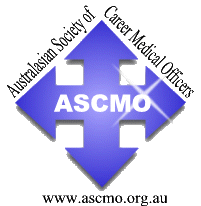
Australasian Society of
Career Medical Officers
www.
ascmo.org.au
CMOA Submission to Australasian Society of Emergency
Medicine
1999
Whats New ?
Members only
Industrial info
Education
CPDP
Jobs for CMOs
Links
CMO Bulletin
About us
Join us
Next Meeting
Open Forum
Disclaimer
Discussion
Paper on the "Feasibility, Assessment and
Implementation Planning of the AMWAC Emergency Medicine
Workforce Recommendations"
by Dr. Stephen Delprado. (AMWAC =
"Australian Medical Workforce Advisory
Committee") I am writing this paper in response to
a request from the Australasian Society of
Emergency Medicine (A.S.E.M.)
to give the Career Medical Officers (C.M.O.)
point of view, as relates to the above paper. I am the C.M.O.
Association representative on the A.S.E.M.,
a senior C.M.O. who has worked in the South Western Area
Health Service for seven years. There are distinct
problems that I see in the section titled 'Validity and
Feasibility of AMWAC recommendations'. A blinkered approach has
been offered in the assessment of current numbers and
in projection of future numbers. Currently working
in the N.S.W. public hospital system are between 700
and 1000 C.M.O.'s, the majority of whom are based, or
rotate through emergency departments. The exact
number cannot be ascertained because of ambiguity in
the data collection by the N.S.W. medical
registration board's survey which caused many
C.M.O.'s to list themselves as specialists, and many
as registrars and others not to complete the survey. These C.M.O.'s
have not been considered appropriately in any of the
current or future predictions. Firstly, C.M.O.'s
vary. Some work in an equivalent position and with
equivalent skills to specialists. Some work in
equivalent positions with equivalent skills to
registrars. In the statistics gathered they have all
been included as registrars underestimating the
current contribution for patient management. In future
predictions they again have been included as
registrars with no possible allowance for increased
numbers. Future numbers are unknown as the previous
discussion with Federal Government on creating a
C.M.O. training programme have been referred to the
results of the Medical Training Review Panel
(M.T.R.P.) Hospital Medical Officer (H.M.O.)
subcommittee findings, which have not yet been
released. In this
feasibility assessment only one alternative has been
provided which is unfortunate. To truly assess
feasibility one should examine alternatives and
assess cost-effectiveness of alternatives: Alternative
1. The cost
effectiveness of a C.M.O. versus a specialist in
the same role. Alternative
2. The cost
effectiveness of a combination C.M.O. and staff
specialist versus purely staff specialist
management system. Alternative
3. Different
management systems for each hospital according to
requirements, geographic location and casemix. A C.M.O. is
100% clinical management and it costs, for a
C.M.O.3, approximately $90,000 per annum plus
penalty rates. A specialist
if 70% clinical management and with extra leave
entitlements could be considered for discussion
purposes the equivalent of 60% clinical
management giving an effective cost of 166% of a
single base salary of approximately $90,000 per
annum plus penalty rates. The difference
in penalty rates between the current C.M.O. award
and proposed penalty rates in the feasibility
study is a ratio of 299/225.5 based on a single
doctor working 168 hours per week. Applying these
values to the base rate gives a C.M.O. cost of
225.5 (total hours with penalty rates) X $90,000
= $120,803 per C.M.O. 168 (total hours in a week) Applying these
values to the base rate gives a specialist: 1.66
X 299 X $90,000 = $265,896 per Specilist 168
(total hours in a week) I do not wish
in this discussion to debase the value of a
specialist emergency doctor but to reinforce the
value of a C.M.O. None of the models proposed in
the feasibility assessment have combination
C.M.O./Specialist proposals. For example model
one - 24 hour day/7 day cover
replacing 5.5 of the 15.5 FTE with C.M.O.'s could
represent a net saving of 5.5 X 145,093 =
$798,011. This would be relevant primarily to
non-teaching hospitals. Our current C.M.O.
population is primarily in non-teaching hospitals
with Bankstown-Lidcombe Hospital the only N.S.W.
teaching hospital with primarily C.M.O. staffing
in the Emergency Department and I expect this,
with time, to move to more predominant specialist
staffing. The C.M.O. and
Specialist have different training bases, the
specialist more academically trained and thereby
sitting in a higher tier of pay, conditions and
respect - and rightly so. But the C.M.O. should
not be included in the lower tier of the
registrar. The staffing
model I have given may not be as easily extended
to other states, as primarily, it works on the
N.S.W. model. C.M.O. systems vary in other
states. In
Summary: To do an
analysis accurately on future staffing levels,
appropriate measure should be given to each part
of our current staffing levels and extrapolated
into the future and appropriate action
recommended ensures continuation of each level of
expertise. The above
figures are used as examples only and
approximates such as $90,000 base wage have been
used. This base wage would vary according to
seniority of C.M.O. or of staff specialist. Any
correspondence would be welcome. I can be
contacted at Dr. Stephen
Delprado,
The
Hills Private Emergency on (02) 9686 0200 or
in writing:
Assistant Director of Emergency,
The Hills Private Hospital,
499 Windsor Rd.,
Baulkham Hills,
N.S.W. 2153,